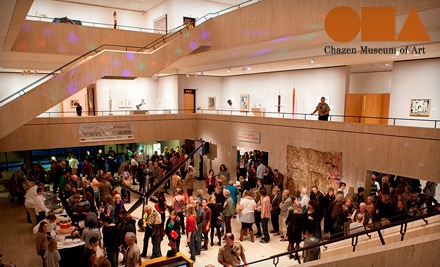Chazen presents sacred Soviet Iconography
By Tyler Riefke
25/3/2011
Newest exhibit combines spiritual themes, artistic aesthetic to give viewers a glimpse of Russian theological history
When viewing the Chazen Museum of Art’s new exhibit, “Holy Image, Sacred Presence: Russian Icons, 1500-1900,” the old is-it-idolatrous-or-isn’t-it conundrum takes a back seat to an appreciation of the at times stunning Eastern Orthodox Iconography presented in the Chazen’s Mayer Gallery.
The exhibit is made up of approximately thirty pieces from the Chazen Museum’s permanent collection. The icons were predominantly gifts of one Joseph E. Davies. Davies served as U.S. Ambassador to the Soviet Union from 1936-38, and collected numerous works of Russian art that was being sloughed by the relatively new Soviet government. The legitimacy (and morality) of these purchases is, to be sure, up for debate.
The icon, as spiritual medium, is intended to evoke sacred presence by appealing to the senses. The first documented Christian icons date back to the second century in what was once the Roman Empire. The ones presented in the museum’s exhibit, which are predominantly products of the Russia of the 17th to 20th centuries, span a variety of Christian themes, aesthetic styles and physical media.
Paintings and etchings of Jesus, Mary and John the Baptist (with head) abound amongst apostles, saints and dragons.
The icons would have been originally found in cathedrals, as a sort of screen or divider (iconostasis) between the congregation and the sanctuary before them; or in a more miniaturized form in the personal prayer space within one’s home; and otherwise scattered about daily Russian life.
They are divided into three to five layers, each layer playing a different role, from representing particular saints before Christ, to telling the more famous Christian stories by intricate series of painted panels. They are meant to represent “portraits” of Christ and the saints as vehicles of prayer, as well as representing the history of the Christian faith.
For believers, the exhibit informs us, icons are inseparable from the ritual of the sacred space where images, sounds and emotions come together. The exhibit places the iconic images within a context that impresses upon the viewer their significance for both everyday ritual observance and for the religious holidays and festivals celebrated by Eastern Orthodox Christians.
One instructional placard quotes Theodore the Studite, a Byzantine Greek monk of the late 8th and early 9th centuries, in arguing that “the believer did not worship a material object, but instead venerated the figures whose presence was evoked by the icon. That is, icons are a point of access to the sacred.”
In making a case for the icon as a legitimate medium for spiritual connection, an anonymous iconophile is quoted: “A foreigner will remain unmoved before these icons, whereas we are overcome by their mysterious power. Because before these icons, or ones like them, the souls of our forebears poured out their most powerful feelings, because before them they experienced rare flashes of great joy and powerful waves of that great sorrow that faith and faith alone could help them beat.”
It is not difficult to see how, in merely staring at the gold-plate overlays and covers for various icons, and imagining the chiaroscuro of flickering light from a candle flame or lamp, one could be induced to a kind of spiritual trance, verging on the transcendence of which the iconophiles spoke.
The “Holy Image, Sacred Presence: Russian Icons, 1500-1900” will be at the Chazen Museum of Art, in the Mayer Gallery now through June 5.


565002 999044Aw, this was a quite nice post. In concept I wish to put in writing like this moreover ?taking time and precise effort to make an excellent write-up?but what can I say?I procrastinate alot and certainly not appear to get one thing done. 546123
942578 305675Why didnt I think about this? I hear exactly what youre saying and Im so happy that I came across your blog. You actually know what youre talking about, and you made me feel like I ought to learn a lot more about this. Thanks for this; Im officially a huge fan of your weblog 15237